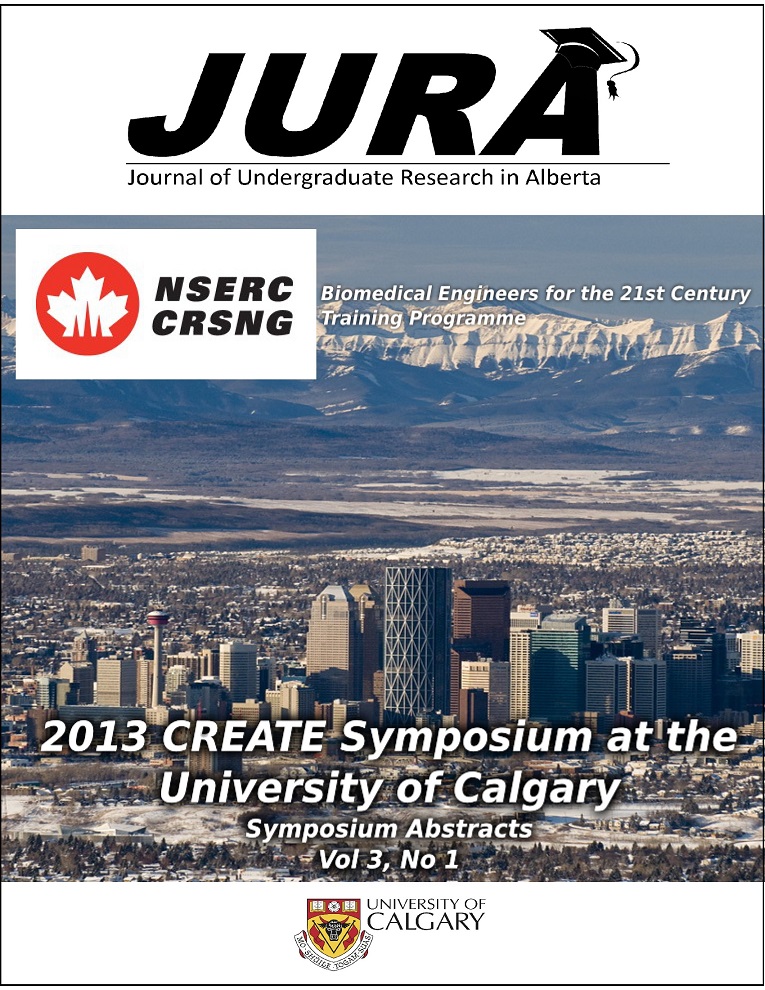Passive coordination of hind limb joints through multi-joint muscles
Keywords:
Joint angles, rabbit hind limb, passive forcesAbstract
PASSIVE COORDINATION OF HIND LIMB JOINTS THROUGH MULTI-JOINT MUSCLES
Violet Campbell, Andrew Sawatsky, Walter Herzog
Human Performance Lab, University of Calgary, Kinesiology Program, University of Calgary
vcampbell@kin.ucalgary.ca
INTRODUCTION
Studies in cats measuring muscle lengths using joint angles show a clear correlation between the movements at the hip, knee, and ankle joints [2]. This correlation could be explained to 70% by a covariance plane between the hip, knee, and ankle joint angles [1]. It has been suggested that the multi-joint muscles may be the origin of the passive limb mechanics [1,4]. EMG recordings show that during cat locomotion, activation of the muscles extending the knee occurs 30-70msec after the knee extension begins; thus the onset of knee extension seems to be controlled passively by the extensor muscles [3]. Furthermore, it has been said that muscles directly change joint angles [4]. The purpose of this study was to examine the effects of multi-joint muscles on the passive joint alignment in the rabbit hind limb. We hypothesize that the hip, knee, and ankle joint angles in the rabbit hind limb are coordinated by passive forces and the passive joint alignment is controlled primarily by the multi-joint muscles.
METHODS
Five New Zealand white rabbit cadavers were used. The joints were marked with bone pins, and the condyles of the femur were held and the hip joint was passively moved through its range of motion while associated changes in knee and ankle joint angles were measured. Hind limb joint movements were recorded using high speed video. Individual video frames were then extracted and digitized manually to obtain the hip, knee and ankle joint angles. Variance was approximately ±5º for each of the joint angles in repeat trials of the same animal. The multi-joint muscles including the biceps femoris, rectus femoris, semitendinosus, plantaris, medial and lateral gastrocnemius, extensor digitorum longus and tensor fascia latae were selectively cut in three hind-limbs, and in a different order for each leg, to identify the contribution of each muscle to the passive coordination of the hind-limb joints.
RESULTS
Before any muscles were cut 80-99% of the variability of the knee and ankle joint angles was explained by variations in the hip angle. As multi-joint muscles were cut sequentially the correlation between hip, knee, and ankle joint angles decreased, and was eventually completely lost (Figure 1).
Figure 1. Passive ankle angles (degrees) as a function of hip angles throughout the entire flexion movement and analyzed every 5˚. The data are from three trials of one rabbit’s hind limb. Blue points (± 1SE) represent the intact leg, orange represents the medial and lateral gastrocnemius removed, and the pink points represent the plantaris was removed in addition to the two heads of the gastrocnemius.
DISCUSSION AND CONCLUSIONS
Removal of selected two joint muscles changed the relationship between passive hip and knee and between passive hip and ankle angles. For example, when removing the gastrocnemius and plantaris muscles, hip motion did not result in any change in the ankle angle, illustrating that all passive force transmission between the two joints hinges crucially on the two-joint triceps surae muscles (Figure 1). In order to identify the precise contribution of each two-joint muscle to passive force transmission across the rabbit hind limb, multiple experiments with different order of cutting the muscles would have to be implemented. Such an extensive experiment was not possible within the framework of this summer.
REFERENCES
- Bosco, et al. J Neurophysiol. 76:715-726, 1996.
- Goslow et al. J Morphol. 141:1-42, 1973.
- Miller et al. Brain Res. 91:217-237, 1975.
- Shen & Poppele J Neurophysiol. 74:2266-2280, 1995.
Downloads
References
2. Goslow et al. J Morphol. 141:1-42, 1973.
3. Miller et al. Brain Res. 91:217-237, 1975.
4. Shen & Poppele J Neurophysiol. 74:2266-2280, 1995.
Downloads
Additional Files
Published
Issue
Section
License
Authors retain all rights to their research work. Articles may be submitted to and accepted in other journals subsequent to publishing in JURA. Our only condition is that articles cannot be used in another undergraduate journal. Authors must be aware, however, that professional journals may refuse articles submitted or accepted elsewhere—JURA included.


